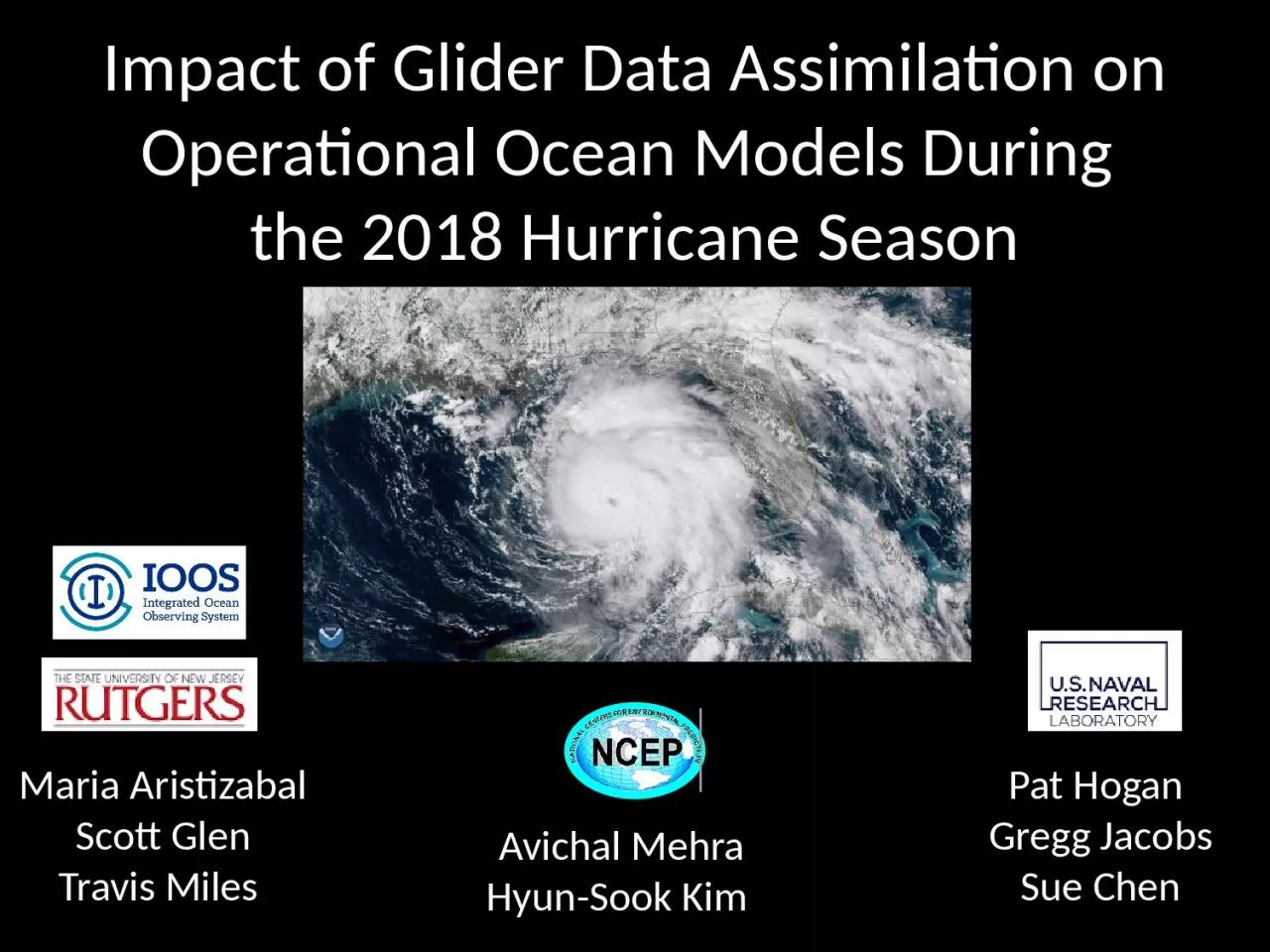

the 2018 Hurricane Season Maria Aristizabal Scott Glen Travis Miles Avichal Mehra HyunSook Kim Pat Hogan Gregg Jacobs Sue Chen Assess the impact of glider data assimilation on the operational hurricane models ID: 1041996
Download Presentation The PPT/PDF document "Impact of Glider Data Assimilation on Op..." is the property of its rightful owner. Permission is granted to download and print the materials on this web site for personal, non-commercial use only, and to display it on your personal computer provided you do not modify the materials and that you retain all copyright notices contained in the materials. By downloading content from our website, you accept the terms of this agreement.
1. Impact of Glider Data Assimilation on Operational Ocean Models During the 2018 Hurricane SeasonMaria AristizabalScott GlenTravis Miles Avichal MehraHyun-Sook Kim Pat Hogan Gregg JacobsSue Chen
2. Assess the impact of glider data assimilation on the operational hurricane models Motivationhttps://www.emc.ncep.noaa.gov/gc_wmb/vxt/HWRF/index.phpHurricane Michael Forecast
3. Mexico Beach After Hurricane MichaelCategory 5 at landfallStorm surge 7.7 feetTotal cost estimated as $25 billion
4. Forecast Guidance for Storm Michael https://www.emc.ncep.noaa.gov/None of the models forecasted the rapid intensificationOfficial forecast predicted a cat 2 at landfallhttps://www.emc.ncep.noaa.gov/gc_wmb/vxt/HWRF/index.phpOct 8/2018
5. NOAA Annual Operational Suite ReviewLimitations on Hurricane Intensity ImprovementComputing resources and model resolution (Rotunno et al., 2009)Poor understanding of the atmospheric boundary layer (Nolan et al., 2009; Andreas et al., 2015)Difficulty in modeling the upper ocean response to storm forcing (Yablonsky and Ginis, 2009). ~ 50%j~ 15 %j
6. Upper Ocean ResponseTemperature and humidity differences at the air-sea interface control the heat fluxes. SST is a relevant ocean quantityDuring a storm, SST is manly controlled by the storm-induced vertical mixing and the strength of the vertical stratificationPrice 2009Hurricane Francis 2004
7. Upper Ocean ResponseIn the continental shelf, there are other physical processes that control SST during storms: shear-induced vertical mixing due to wind-forced two-layer circulation (Glenn et al 2016), upwelling/downwelling circulation depending on the incident angle of the storm (Miles et al 2017) To capture the upper ocean response in the shelf is critical because the SST at the shelf will determine if a hurricane will intensify or weaken before landfall Hurricane Irene (Glenn et al 2016)On ShoreOff Shore
8. How to Improve the Modeling of the Upper Ocean Response During a Hurricane on the continental shelf?Improve the subsurface initial conditions in the operational ocean models: right initial vertical stratification, better evolution of the SST during storms , better heat fluxes estimates
9. How to Improve the Modeling of the Upper Ocean Response During a Hurricane on the continental shelf?Improve the subsurface initial conditions in the operational ocean models: right initial vertical stratification, better evolution of the SST during storms , better heat fluxes estimates Ocean Data Assimilation
10. NOAA Hurricane Forecasting ModelsHWRF/HYCOMHMON/HYCOMHWRF/POMWestPacificSouthPacificNorthIndianSouthIndianCentralPacificEastPacificNorth AtlanticHWRF – Hurricane Weather Research Forecasting ModelHYCOM – Hybrid Coordinate Ocean ModelHMON - Hurricanes in a Multi-scale Ocean-coupled Non- hydrostatic modelPOM – Princeton Ocean Model
11. Kim et al. 2014Hurricane Coupled Ocean-Atmosphere Forecasting Model: HWRF-HYCOM SystemICGOFS/NCODAICRTOFS – Real Time Ocean Forecasting SystemGFS – Global Forecasting System
12. Global Ocean Forecasting System (GOFS) / Navy Coupled Ocean Data Assimilation System (NCODA)Surface DataSatellite SSTSatellite AltimeterIn Situ SSTGOFS/NCODADrifting buoysFixed buoysArgo FloatsGlidersTESACXBTs (only temp.)Subsurface Temperature and Salinity
13. ARGO Floats During the 2018 Hurricane SeasonArgo floats mostly occupy the open oceanOne vertical profile every ten days
14. ARGO Floats and Gliders During the 2018 Hurricane SeasonGlider observations are mostly in the shelfTens of profiles per day
15. 62 Gliders in the IOOS Glider Data Assembly Center (DAC) During Hurricane Season 2018
16. Hurricane Michaelng288Seven Navy gliders reporting to the glider DACin the GoM during hurricane MichaelNg288 was at 36 km from the eye of hurricane Michael
17. NCODA Temperature IncrementsJason 2CryoSatArgoThe increment is the change made to the model state at the end of the previous assimilation cycle
18. IncrementsInsertion WindowHurricane MichaelIncrementsInsertion WindowThe assimilation of glider data days ahead of Michael corrected the position of the thermoclineIncrementsInsertion Window
19. IncrementsInsertion WindowHurricane MichaelIncrementsInsertion WindowThe modeled SST increased after the passage of Michael: the ocean response is faster than the 1-day assimilation cycle
20. Glider Data vs Operational Models During Michael
21. Glider Data vs Operational Models During MichaelThe ocean under the operational hurricane models have a thermocline that is too shallow and does not completely capture the magnitude and timing of cooling and subsequent mixing
22. Ongoing collaboration with NCEPOngoing and Future Work2018100718 ForecastAvichal MehraHyun-Sook Kim
23. Quantify Impact of glider observations on operational hurricane modelsOngoing and Future Work2018100912 forecastCOAMPS-TC forecast intensity was weaker than the real-time best trackAssimilating the gliders improved the Hurricane Michael’s track forecastDA, glidersDA, no gliders Observation
24. Conclusions The data assimilation ahead of a storm is critical to ensure that the models have the right initial vertical stratificationThe length of the assimilation cycle in NCODA needs to be short enough to be able to capture the rapid ocean response during a hurricaneThe ocean models underneath the NOAA hurricane forecasting models are not getting the benefit of DA though GOFS/NCODAWe will continue collaborating with NCEP and NRL during the 2019 hurricane season